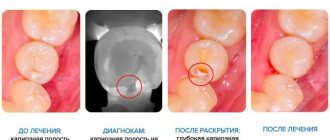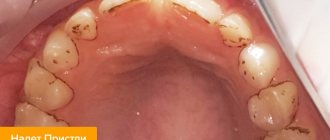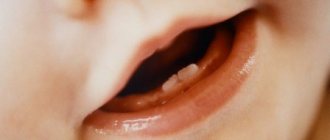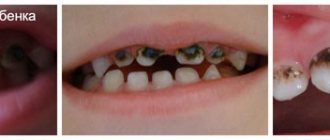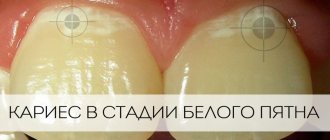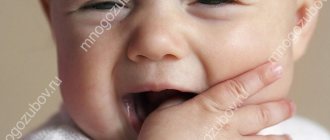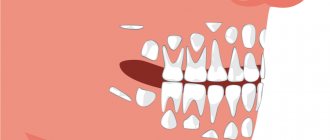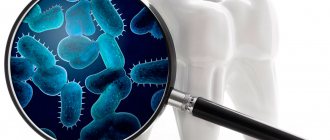Treatment of dental pathologies in children is a complex process that requires extensive practical experience and knowledge of child psychology. Especially when it comes to baby teeth. In order not to damage the rudiments of permanent units, the doctor must perfectly know the technique of performing manipulations and act very carefully.
Children's doctors at the Levoberezhnaya Dental Clinic try to save teeth even with extensive damage and remove them only as a last resort. You can make an appointment by calling the phone number listed on the website or using the online form.
Treatment of caries of children's primary teeth
Caries of primary chewing and front teeth has long been treated without the slightest pain.
New modern techniques have reduced the use of drills and drilling to a minimum, and timely scheduled examinations make it possible to detect the disease at a very early stage. The doctors at Aza&Buka Pediatric Dentistry who work with young patients are distinguished by an amazing sense of tact and constant positivity. Knowledge of the child’s psychology allows doctors to build communication and dialogue in such a way that children sit in the dental chair without the slightest fear. If the child already has some dental phobia, then adaptation techniques can solve the problem.
Caries on baby teeth in children is treated using the following technologies:
How is dental treatment performed for children under anesthesia?
During treatment under general anesthesia, the child does not feel anything. And he doesn’t remember anything after waking up. This is achieved by a combination of drugs. The main one among them is Sevoran.
The combination of drugs and their doses are calculated individually for each child. In this case, the doctor takes into account the age, weight and characteristics of the small patient. The use of combinations of anesthetics makes it possible to minimize their doses and carry out a high-quality and safe procedure.
The child falls asleep after a few breaths through the mask of the anesthesia machine. This happens in the arms of the mother. We perform induction of anesthesia as comfortably as possible for the baby. If a child comes with his favorite toy, we show her by example: inhalation from a mask is not scary.
In cases where parents warn the anesthesiologist that even a mask causes negative emotions in the child, premedication can be used. Then we administer a mild sleeping pill to the baby in the form of nasal drops, after which the child plays or watches cartoons for 30-40 minutes and gradually falls asleep in his mother’s arms. And then we begin induction of anesthesia.
An anesthesiologist and a nurse anesthetist are responsible for administering general anesthesia. Their interaction ensures the safety of the child. The baby is under constant control, precisely calculated doses of drugs are administered at the appropriate time. It takes approximately 30 minutes in addition to the treatment time for the anesthesiologist to induce anesthesia and wake up.
Classic filling
requires a special approach when treating young patients, since the doctor has to use dental equipment, which often causes fear in children.
Aza&Buka dentistry uses both traditional and modern methods of treating caries of primary teeth, selecting a method taking into account the age of the child and the degree of neglect of the process.
Plaksina Margarita
“Modern parents are great! They themselves are not afraid of dentists, and children are taught the same thing: to come on time for preventive appointments and examinations. In such cases, doctors can intercept the very beginning of a cavity infection and prevent tooth decay without drilling.”
How to prepare a child for dental treatment under anesthesia
- Before treatment, you should consult with an anesthesiologist. This can usually be done over the phone, but in some cases a face-to-face appointment is required.
To correctly administer general anesthesia, the anesthesiologist will need the following information:
- child development history;
- allergic reactions;
- past acute and chronic diseases;
- previous medical interventions and hospitalizations;
- anthropometric data (age, height, weight).
To clarify the child’s health status, you will need to undergo a series of tests. The anesthesiologist determines the full scope of the required examination based on the characteristics of the small patient and the type of upcoming treatment.
- Before anesthesia, diet is very important. The safety of anesthesia depends on its compliance.
The child who will best tolerate anesthesia is the one who:
- did not eat “heavy food” during the 6 hours preceding treatment;
- 4 hours before the procedure I had a snack;
- I drank water 2 hours before.
Dietary recommendations may vary, so the final meal plan will be discussed in consultation with the anesthesiologist.
- To help parents not be nervous, I also recommend asking the anesthesiologist what his qualifications are and what equipment he will use during the procedure. You definitely shouldn’t be embarrassed about such questions. Doctors with experience in pediatric anesthesiology should work with children, since the structure of the child’s body and its functioning have their own characteristics.
Milk caries: initial, superficial, medium, deep
Doctors distinguish 4 stages of the formation of carious areas:
- Initial caries - tooth enamel becomes covered with small spots of white or yellowish tint.
- Superficial caries - the enamel begins to deteriorate, small and light cavities are observed.
- Medium – the layer of tooth enamel is destroyed, the affected area extends deeper.
- Deep - the layers of dentin have already been affected, and the pulp is under threat.
It is necessary to treat milk caries at the very first stage, although it does not cause any discomfort in the child. The fact is that the enamel and crowns of temporary teeth are subject to rapid destruction, and the development of caries occurs very quickly. Deep caries often provokes irreversible changes, which leads to premature removal of the baby tooth.
Rodikova Tatyana
“Medium and deep caries most often occurs in schoolchildren, almost teenagers. Children brush their teeth poorly, and they talk about problems only when caries has already affected the pulp. In this case, the treatment turns out to be more unpleasant, since removal of the pulp cannot be avoided. That’s why I always ask parents to carefully monitor their teenagers’ hygiene and bring them to appointments on time.”
Oral care
Caries in children aged 2-3 years can also develop due to the inattentive attitude of parents. Let's look at the main mistakes that moms and dads make:
- Pacifiers and bottles in a dream.
To teach a child to sleep alone, parents give him a pacifier or even a bottle of milk at night. As a result, the child enjoys the sweet taste of the drink all night, and the teeth are slowly but surely destroyed. Such a habit, of course, will give mom and dad healthy sleep, but in the baby it can lead to bottle caries and malocclusion.
- Sweet life.
Of course, most kids are unfamiliar with the problem of excess weight. Therefore, grandparents strive to treat the child with additional cake or candy. And, as you know, bacteria on enamel love sugar with a tender love, and very soon children under 3 years old develop caries, which requires treatment.
- Insufficient dental care
. Many parents believe that there is no need to care for baby teeth at 2-3 years of age. As a result, plaque accumulates, and carious monsters spread over both grown and still growing teeth.
Symptoms of caries in babies
It can be difficult for parents to notice that their child’s teeth are affected by caries. Dentists distinguish several stages of the development of the disease:
- Initial.
Subtle white spots appear on the baby's teeth. These spots can be large or very small, round or rectangular. The child does not experience any unpleasant sensations at the initial stage. Therefore, parents who do not examine their children's teeth skip this stage, and the enamel continues to deteriorate.
- Superficial
. At this stage of caries, teeth change more noticeably: dark spots appear on the top layer of enamel. Some children complain of pain when eating irritating foods (sour, salty and sweet). The enamel is damaged, the tooth cavity opens to bacteria.
- Average
. Caries bacteria reach the dentin (the tissue located inside the tooth). The baby complains of pain when eating foods that are too cold or too hot.
- Deep.
In children, deep caries is much more difficult than in adults. Most of the internal tissue of the tooth is damaged, and pulpitis develops sharply.
Unfortunately, in children under 3 years of age, unlike adults, caries often affects all teeth at once. Several holes may appear on one crown from different sides at once. Therefore, parents need to be extremely attentive to their children and devote time to oral care even before the first tooth appears.
Reasons for the development of caries in temporary teeth
When visiting a dentist, parents are invariably interested in the reasons for the appearance of such an unpleasant disease. This is important because it helps prevent damage to new teeth. Sometimes it is enough to change eating habits and hygiene patterns so that the child forgets about fillings for a long time, and only comes to the dentist for examinations.
Causes of caries:
- Poor or insufficient oral hygiene. Food remains in the interdental space and on the enamel are an excellent environment for the development of carious bacteria.
- An unbalanced diet with a preponderance of sweets and carbohydrates - during the fermentation of simple carbohydrates, acids are formed that provoke the destruction of enamel.
- The lack of solid foods in the menu leads to a decrease in the frequency of chewing, reduces salivation and becomes a common cause of caries of primary teeth in young children.
- Long-term use of nipples, including on bottles and sippy cups, increases the risk of developing single or multiple bottle caries of the anterior milk teeth in children.
- Rickets is a pathology that provokes the destruction of dental tissues.
- Genetic predisposition of the child.
- Problems with bite – various anomalies in the formation of the dentition.
- Decreased natural immunity due to frequent acute respiratory viral infections, chronic diseases, and taking various medications.
- Damage to tooth germs in the prenatal period - due to maternal illness or neglect of health in the first trimester.
Why do babies get caries?
Yes, caries in children under 3 years of age still surprises parents. "How so? After all, the baby doesn’t even know cigarettes and soda yet?” - they shrug their shoulders. In fact, there are two main groups of reasons for the appearance of caries in babies: poor lifestyle during pregnancy and insufficient oral care for the child after birth. Let's look at each group separately.
Pregnancy
The expectant mother should be especially attentive to herself. The baby's teeth begin to develop around the 12th week of pregnancy. It is important for a woman to understand that the process of feeding a child is a process that begins with conception.
For the health of the baby’s teeth, hair, nails, skin and other organs, the expectant mother should choose natural products that contain the daily requirements of essential vitamins and minerals:
- Dairy
. First of all, the expectant mother should choose cottage cheese, natural yogurt and hard cheeses. These treats contain calcium, protein, vitamins B, D, and Omega-3 polyunsaturated fats that baby’s teeth need.
- Nuts
- This is a storehouse of vitamins and nutrients necessary for the formation of teeth in a baby. Nuts contain selenium, magnesium, vitamin E, phytic acids and Omega-3 polyunsaturated fatty acids.
- Fish and seafood
. Everyone knows that fish contains the phosphorus needed by bones and teeth and beneficial vitamin D, which strengthens the nervous system of a pregnant woman and baby.
- Meat, liver
. Important cell building materials are meat and liver. These products contain the protein necessary for a growing body. The liver is rich in iron and B vitamins.
- Chicken and quail eggs
. These products contain more than 10 useful vitamins and microelements that affect the growth and abilities of the baby.
- Vegetables
. Vitamins, fiber, microelements and organic acids necessary for the development of healthy baby teeth are found in abundance in vegetables. Avocados, broccoli and carrots are especially useful for the expectant mother. These vegetables (in any form - raw or cooked) contain the most calcium, vitamins B, C and folic acid.
- Berries and fruits
– vitamin support for pregnant women and the key to the normal development of the child.
- Legumes
contain iron, folic acid and vitamin B-6, necessary for mother and baby.
- Cereals
rich in B vitamins, fiber and iron. Milk porridge will be very useful.
- Spinach.
The plant contains a lot of folic acid, calcium and vitamin A. In addition, the leaves are not at all difficult to grow at home on the balcony, and then enjoy them in the form of soups, purees and side dishes.
And, of course, the expectant mother should avoid taking antibiotics: such drugs can destroy the child’s health.
What is rehabilitation like after treatment under anesthesia?
After waking up from anesthesia, in the vast majority of cases, children feel well. Most often, the only thing that bothers them is numbness in the areas where the local anesthetic was injected.
As for behavioral changes, there are three types:
- excitement - the baby may be capricious and cry. This is accompanied by increased activity. But it quickly gives way to fatigue;
- fatigue - the child wants to sleep, refuses to eat, sits in the arms of the parents;
- no behavioral changes after waking up.
The first two scenarios are typical for children under the age of 7-10 years, the third - for adolescents and adults.
Hyperactivity and agitation upon awakening are unpleasant for both the child and those around him. To avoid it, we try to implement the second scenario; to do this, we put the baby to sleep and wake him up gently.
The child can eat immediately after waking up, unless the anesthesiologist gives other recommendations.
Very rarely, recovery from anesthesia is accompanied by nausea or a feeling of motion sickness. This lasts no longer than 2-3 hours. This reaction is typical for children who get motion sickness in transport. In this case, you will be able to eat and drink within an hour or after the nausea has passed.
There is no need to worry about the postoperative period - the anesthesiologist will always be in touch.
Pediatric dentistry Natadent
You need to take care of your teeth even before birth
Conscious parents always take care of the future of their children, in particular their health. A beautiful smile is an external standard of health and an excellent investment in success. Research by leading experts in the field of pediatric dentistry has confirmed that the risk of children developing dental caries is reduced by almost 50% if their mother had a healthy oral cavity during pregnancy.
Dental treatment without tears
Modern dentistry is replacing tears! In our clinics you will not see sad, crying children; we do everything to minimize unpleasant sensations. Microinvasion - implies minimal impact on the small patient; there is no longer a buzzing drill, but there is a special softening gel, non-contact treatment of the tooth with a water stream and cheerful multi-colored fillings. In addition to pain-free treatment, there is much more to offer, such as a playroom for children and high-speed Wi-Fi.
Colored fillings
We try to do everything possible to make it easy and fun for children in our clinics. A special gel allows us to soften the hard tissues of a damaged tooth. Special equipment helps to avoid drilling and process the cavity without contact. And our cheerful and colorful fillings are unbeatable! Safe and reliable fillings of different colors, from which your child will choose what he likes.
Trusting relationship between child and doctor
The main rule of our dentists is to establish friendly contact with young patients. The program for a child’s visit to the dentist traditionally includes:
- acquaintance in the playroom;
- face painting;
- watching cartoons;
- keepsakes.
The clinic’s doctors know very well what dentistry is for children and how sensitively children sense falsehood, so they base any games and procedures on sincerity, empathy, and respect for their interlocutors. Diagnosis and treatment with us will not be stressful for a fragile psyche.
Families choose us!
After visiting our clinic, children literally infect their parents with their confidence, and they, in turn, also become our patients. For many, we have gradually changed from children's dentistry to family dentistry, and this makes us happy. In addition, we have a full range of services including: therapy, periodontics, surgery, orthopedics and implantology.
We pay special attention to dentistry for pregnant women. Young mothers willingly bring their children to us, since they have already developed a trusting relationship with the doctor even during pregnancy.
Many people like to treat their teeth with pleasure with the whole family, and the convenient location of the clinics in relation to the metro in the Central Administrative District and Northern Administrative District of Moscow plays an important role in this.
Prevention saves budget
The optimal frequency for a child to visit the dentist is approximately three to four times a year. In the presence of chronic diseases or abnormalities identified by pediatrics, the frequency of visits may vary, since the child must be under more careful supervision. The health of a child’s teeth is the basis for the further, correct and complete development of the baby, because elementary caries can become a source of inflammation and affect the condition of the body for the worse. We teach our young patients about oral hygiene in a simple, visual manner, show them how to properly care for their teeth, and many parents are grateful to us for the fact that we not only treat caries. Come visit us, Natadent children's dental clinics hold regular promotions and offer discounts.
Convenient and comfortable!
If you are faced with a choice: “Which pediatric dentistry in Moscow should you visit with your child? Visit any of the Natadent clinics and you will definitely make sure that you have taken the right step. The entire range of dental services for adults and children, modern technological solutions and equipment - this is dentistry for children in Moscow “Natadent”. Every doctor in our clinic is not just a pediatric dentist, but also a child psychologist to the highest degree. We will not just fix your baby’s teeth, we will make friends with him and thereby establish a positive attitude towards doctors for many years.
How to choose a doctor for your child
A child's first visit to the dentist is a very important event that should be taken very seriously. It is imperative to find a doctor who gets along well with children and to whom the child will go with great pleasure. This will determine whether he will have a fear of dentists in the future.
It is recommended that you spare no expense for the first time and take your child to a paid clinic . In such institutions, treatment is accompanied by a friendly attitude from the staff; children are often shown cartoons and given toys to play with.
The importance of brushing your teeth daily
- Malyshariki
. The series is called “Brush”. In a playful way, it shows how to brush your teeth correctly. - Fixies.
The series is called “Toothbrush”. After watching this cartoon, your child will become familiar with the device of a modern electric toothbrush. Advice from Fixies: “It’s better to brush your teeth often than to have them repaired by the dentist often.” - Fixies.
The series is called “Toothpaste”. A very educational series not only for children, but also for their parents. This series tells us that pastes are divided not only into adults and children, but also that children's pastes also differ in composition, depending on the age of the child. The series also touches on the extremely pressing issue of how to properly motivate a child to brush their teeth regularly and correctly. - Three kittens.
The episode is called “This is how we brush our teeth.” - Lu Lu explores the world
– series “Brushing our teeth with Lu Lu”
The following cartoons will be useful for children aged four years and older:
Personal experience.
Not all dentists are ready to seek an approach to children.
Doctors at public clinics work on a whim - appointments are limited in time, they do everything quickly and efficiently, without friendliness or comfort. Pain during treatment leads to the formation of a persistent fear of dentists. Rodikova Tatyana
“Soviet dentistry perpetuated fear of dentists among adults. The grinding sound of a drill, treatment without injections... But today there is nothing like that anymore. Modern technologies mean treatment without pain, so, dear parents, do not broadcast your fears to your children! A comfortable and pleasant treatment awaits them. Especially in "Azabuka".
Many parents find out in advance what is harmful and beneficial for the baby, and do not allow such situations. But if children have already begun to be afraid of dentists, then they need to deal with fears consistently and carefully.
